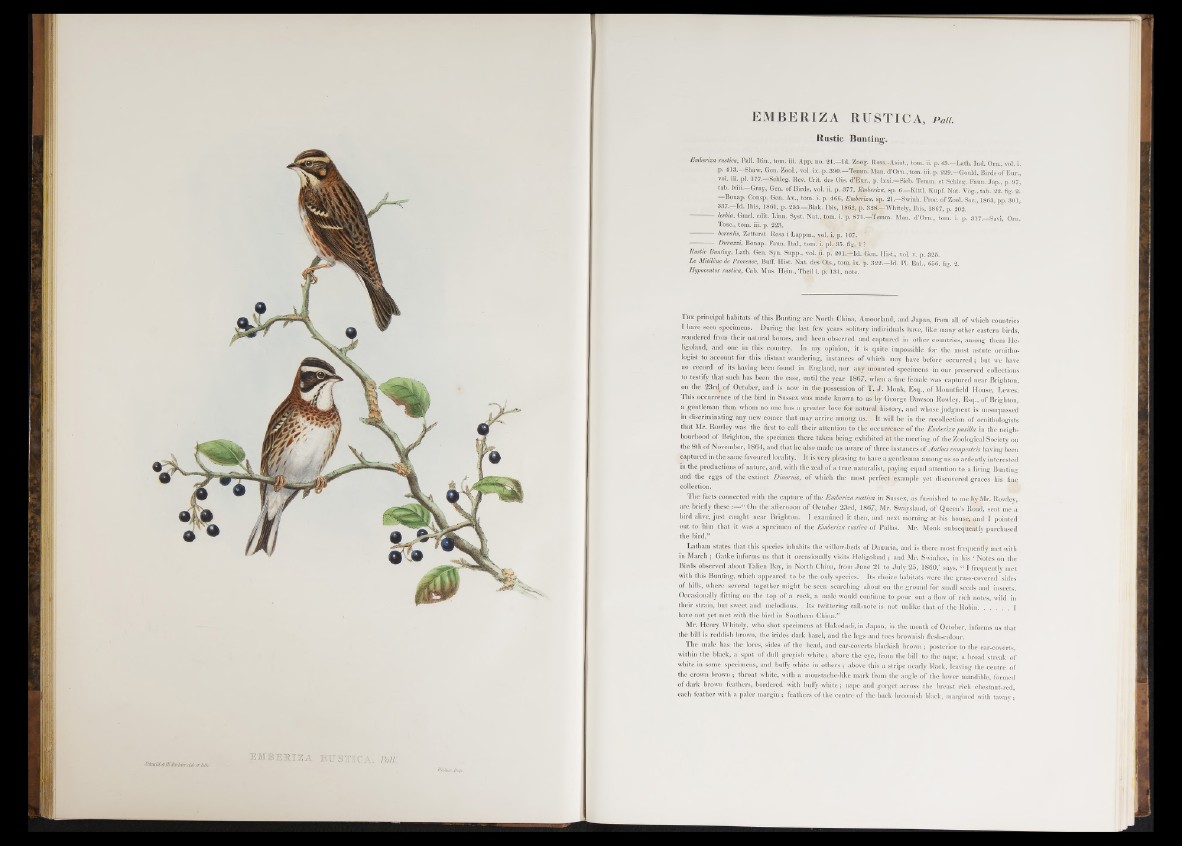
Jôadd/SiECBieiaa-. dcL eb Mu
Rustic Bunting-.
Emberiza rustica, Pàli. Iti©., tom. iii. App. no. 21.- I d . Zoog. Ross.-Asiat, tom .É I p. 4 3 .-L a th . Ind. Ora., voi. i.
p. 413— Shaw, Gen. Zool., voi. ix. p. 390.—Temm. Man. d’O rn., torn. iii. p. 2 2 9—Gould, Birds o f Eur.,
voL W- pi- 177.—iSchleg. Rev. Crit. des Ois. d’Eur.¿ p. lxxi.—-Sieb. Temm. e t Schleg. Faun. Jap ., p. 97,
tab. lv iii— Gray, Gen. o f B irds, vol. ii. p. 377, Emberiza, .sp. 6.—Kittl. Kupf. Nat. V o g.,tab. 22. fig. 2.
—Bonap. Consp. Gen. Av., tom. i. p. 466, Emberiza, sp. 21.—jSwinh. Proc. of Zool. Soc;, 1863, pp. 301,
337.—Id. Ibis, 1861, p .. 255.—Blak. Ibis, 1862, p. Á ^ Í^W h ite ly , Ibis, 1867, p. 202.
— lesbia, Gmel. edit. Linn. Syst. Na t., tom. i. p^871.—Temm. Man. d’O rn., tom. i. p. 317.—Savi, Ora.
Tose., tom. iii. p. 223.
------------ borealis, Zetterst. Resa i Lappm., vol. i. p. 107. 1 '
------------ Durazzi, Bonap. Faun. Ital., tom. i. pl.^35. fig. Jt'P ” -
Rustic Bunting, Lath. Gen. Syn. Supp., r o l .S ■£. 201. ETist., vol. v. ¡,. s i s .
Le Mitilène de Provence, Buff. Hist. Na t. de§*Qis., toig. i / 'j ) . 322.- - id . PI. Enl.t 656. fig. 2.
Hypocentor rustica, Cab. Mus. Hein., Theil i. pi 15l!;' note.
T h e principal habitats o f this Bunting are North China, Amoorland, and Japan, from all of which countries
I have.seen specimeps. During the last few years solitary individuals have, like many other eastern birds,
wandered from their natural homes, and been observed and captured in other countries, among them Heligoland,
and one in this country. In my opinion, it is quite impossible for the most astute ornithologist
to account for this distant wandering, instances of which may have before occurred ; but ive have
no record of its having been found in England, nor any: mounted specimens in our preserved collections
to testify that such has been the ease, until the year 1867, when a fine female was captured near Brighton,
on the 23rd, of October, and is now in the possession of T . J . Monk, Esq., of Mountfield House, Lewes.
This occurrence of the bird iu Sussex was made known to us by George Dawson Rowley, Esq., of Brighton,
a gentleman tha® whom no one has a greater love for natural history,¿Bid whose judgment is unsurpassed
discriminating any new comer that may arrive among w ^ f l t will be in the recollection of ornithologists
that Mr. Rowley was the first to call thpipattention to the occurrence o f the Emberitsa pusilla in the neighbourhood
of Brighton, the specimen there taken being exhibited a t the meeting of the Zoological Society on
the 8th o f November, 1864, and that he also made us aware of three instances o f Antlus campestris having been
captured in the same favoured locality. I t is very pMSsjng.to have a gentleman among us so ardently interested
in the productions o f nature, and, with the zeal of a true naturalist, .paying equal attention to a living Bunting
and the eggs of the extinct Dinomis, of which the most perfect example yet discovered graces his fine
collection.
The facts connected with the capture of the Emberiza rustica in Sussex, as furnished to me by Mr. Rowley,
are briefly these “ On the afternoon of October 23rd, 1867, Mr. Swayslaud, of Queen’s Road, sent me a
bird alive, ju st caught near Brighton. I examined it then, and next morning a t his houses and I pointed
out to him that it was a specimen of the Emberiza rustica o f Pallas. Mr. Monk subsequently purchased
the bird.”
Latham states that this species inhabits the willow-beds of Dauuria, and is there most frequently met with
in March ; Gatke informs us that it occasionally visits Heligoland ; and Mr. Swinhoe, in his ‘ Notes on the
Birds observed about Talien Bay, in North China, from June 21 to July 25, I860,’ says, “ I frequently met
with this Bunting, which appeared to be the only species. Its choice habitats were the grass-covered sides
of hills, where several together might be seen searching about on the ground for small seeds and insects.
Occasionally flitting on the top o f a rock, a male would continue to pour out a flow of rich notes, wild in
their strain, but sweet and melodious. Its twittering call-note is not unlike that of the Robin..................... I
have not yet met with the bird in Southern China.”
Mr. Henry Whitely, who shot specimens at Hakodadi, in Japan, in the month o f October, informs us that
the bill is reddish brown, the irides dark hazel, and the legs and toes brownish flesh-colour.
The male has the lores, sides of the head, and ear-coverts blackish brown ; posterior to the ear-coverts,
within the black, a spot of dull greyish white ; above the eye, from the bill to the nape, a broad streak of
white in some specimens, and buffy white in others ; above this a stripe nearly black, leaving the centre of
the crown brown ; throat white, with a moustache-like mark from the angle of the lower mandible, formed
of dark brown feathers, bordered with buffy white ; nape and gorget across the breast rich chestnut-red,
each feather with a paler margin ; feathers of the centre of the back brownish black, margined with tawny •